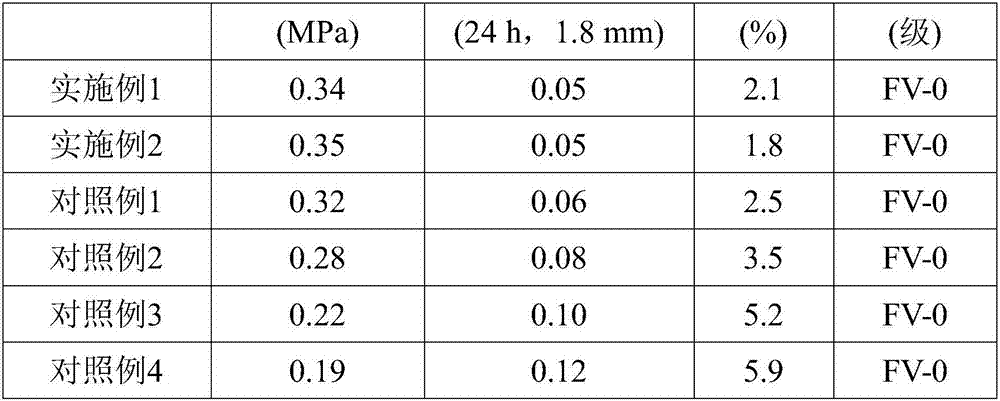Inner-channel sealant for hollow glass processing and preparation method thereof
A sealant and glass technology, used in adhesives, epoxy resin adhesives, adhesive additives, etc., can solve the problems of low water vapor transmission rate and cold flow rate, affecting the use effect, and dew point of insulating glass, and achieve water vapor Low transmittance and cold flow rate, prevention of failure, good flame retardancy
- Summary
- Abstract
- Description
- Claims
- Application Information
AI Technical Summary
Problems solved by technology
Method used
Image
Examples
Embodiment 1
[0021] (1) Add 1g of trimethylolpropane triglycidyl ether and 1g of bismaleimide resin with an acid value of 40mg KOH / g to 5g of polyethylene glycol monomethyl ether-polyglutamic acid, and heat Heat and mix for 10 minutes at 120-130°C, then add 0.5g of sepiolite fiber powder, and continue to heat and mix at 120-130°C for 5 minutes to obtain flexibility additives;
[0022] (2) Mix 15g of bisphenol A epoxy resin-hydrolyzed polymaleic anhydride, 10g of polytetrafluoroethylene ultrafine powder, 5g of fly ash, 5g of polyethylene oxide and flexibility additives and send them to the mixer , And kneading at 130-140℃ for 10min to obtain inner sealant.
[0023] Preparation of bisphenol A epoxy resin-hydrolyzed polymaleic anhydride: microwave 15g of bisphenol A epoxy resin at a microwave frequency of 2450MHz and an output power of 700W for 5 minutes, and then add 5g of hydrolyzed polymaleic anhydride and 0.05g of bisphenol A Ferrocene, fully mixed, continue microwave treatment for 10 minutes...
Embodiment 2
[0026] (1) Add 3 g of trimethylolpropane triglycidyl ether and 0.5 g of bismaleimide resin with an acid value of 40 mg KOH / g to 5 g of polyethylene glycol monomethyl ether-polyglutamic acid, and Heat to 120-130°C and keep mixing for 15 minutes, then add 1g of sepiolite fiber powder, and continue to keep the temperature and keep mixing at 120-130°C for 10 minutes to obtain flexibility additives;
[0027] (2) Mix 15g of bisphenol A epoxy resin-hydrolyzed polymaleic anhydride, 15g of polytetrafluoroethylene ultrafine powder, 10g of fly ash, 5g of polyethylene oxide and flexibility additives and send them to the mixer , And kneading at 130-140℃ for 10min to obtain inner sealant.
[0028] Preparation of bisphenol A epoxy resin-hydrolyzed polymaleic anhydride: 10g of bisphenol A epoxy resin was microwave treated at a microwave frequency of 2450MHz and an output power of 700W for 5 minutes, and then 2g of hydrolyzed polymaleic anhydride and 0.05g of bisphenol A Ferrocene, mix well and co...
Embodiment 3
[0049] The use performance test of the inner sealant prepared in Example 1, Example 2, Control Example 1, Control Example 2, Control Example 3, and Control Example 4 was carried out, and the results are shown in Table 1.
[0050] Table 1 Performance of the inner sealant made in the embodiment of the present invention
[0051]
[0052]
PUM
| Property | Measurement | Unit |
|---|---|---|
| acid value | aaaaa | aaaaa |
| particle size | aaaaa | aaaaa |
Abstract
Description
Claims
Application Information
 Login to View More
Login to View More - R&D
- Intellectual Property
- Life Sciences
- Materials
- Tech Scout
- Unparalleled Data Quality
- Higher Quality Content
- 60% Fewer Hallucinations
Browse by: Latest US Patents, China's latest patents, Technical Efficacy Thesaurus, Application Domain, Technology Topic, Popular Technical Reports.
© 2025 PatSnap. All rights reserved.Legal|Privacy policy|Modern Slavery Act Transparency Statement|Sitemap|About US| Contact US: help@patsnap.com


